Blocks and Building
posted by Diann Gano
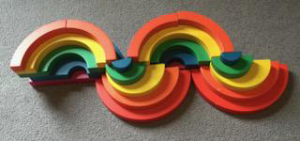 I am block crazy. I love blocks, particularly wooden blocks. Block play is so important in the early years to help children understand important concepts in measurement, spatial reasoning, comparison, estimation, symmetry, and balance. It fosters creativity and reasoning skills. Our home runneth over with blocks and we very often take these blocks outdoors. With all the emphasis on STEM and STEAM these days, block building is our passion, which fits in just wonderfully. You can’t teach creativity. It is learned through play; through trial and error and gifts of time to make their works of mastery grow.
I am block crazy. I love blocks, particularly wooden blocks. Block play is so important in the early years to help children understand important concepts in measurement, spatial reasoning, comparison, estimation, symmetry, and balance. It fosters creativity and reasoning skills. Our home runneth over with blocks and we very often take these blocks outdoors. With all the emphasis on STEM and STEAM these days, block building is our passion, which fits in just wonderfully. You can’t teach creativity. It is learned through play; through trial and error and gifts of time to make their works of mastery grow.
Unit blocks used to be the standard in kindergarten classes across the nation. Teachers aren’t given the time or opportunities to allow children to explore with these very much anymore. It is vital that our children have time to play with these wonderful blocks. They are pricey, but definitely will be passed down for generations. We actually have a small set our family used fifty years ago, included in our block area.
We have unit blocks in all sizes. There are tabletop versions and large hollow unit blocks. The hollow blocks also come in a smaller preschool size. We like to use those inside and the full-size hollow blocks outdoors. We also have Kapla blocks, Magnatiles, tree blocks, Legos, Duplos, Tegu, Korxx, the list goes on and on. We love them all.
My obsession with blocks may be partially responsible for the amount of building that happens daily, almost hourly around here. Block building is full of math learning possibilities. We have blocks in every room of our home, but we build indoors and outdoors with things other than blocks. When children learn to create with blocks, they take those skills and re-create that building in larger and smaller scales with supplies that are made available. Yes, loose parts!
Before I share with you our outdoor building set up, I want to share a bit about two of the blocks I mentioned above. The Korxx blocks are literally made from cork. They come from Germany and we have left them outdoors. That was the primary reason I bought them in the first place. However, the minute my “not so loving all these blocks” husband laid eyes on them he was sold. Why? They don’t crash and knick our hardwood floors. J True. So if that has been an obstacle for you and blocks, try these blocks. They stack great, they are quiet and are pretty close to unit blocks!
I also mentioned Tegu blocks. For those of you who haven’t been introduced to these, they are magnetic. The secret is the magnets are built inside these wooden blocks, so there is never a fear of choking or swallowing with young children. Genius, right? They also challenge our kids to figure out the polarity of the magnets, which is a true critical thinking skill, which we love! Tegu blocks are made by a socially responsible company that treats it’s workers, the land, and the people kindly. You can learn more about these beautiful and addictive blocks here.
SETTING THE STAGE
On days when the yard is too muddy, the sun and humidity are stifling, or we have all just hit the wall and need a calming day, I set the stage. I usually do this on our deck, but depending where the sun or shade or wind is, other parts of our outdoor play space work also. You need a flat space to build on. The deck, sidewalk, any flat area will work. A sheet of plywood covered by a blanket or rug will suffice.
When setting the stage for block play, I usually start with the unit blocks, but we have acquired a large number of wooden blocks of different shapes and sizes that create for some wonder hours of play.
One of the reasons that I love blocks so much is that although it is often a group activity, it is very individualized.
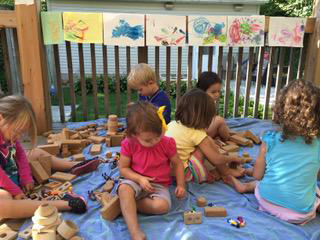 There are six children playing blocks, they are all getting along just great because they are sharing space. They aren’t sharing blocks or ideas. It is very personal play above. It’s not always like that. It was on this given day. It’s the beauty of block play.
There are six children playing blocks, they are all getting along just great because they are sharing space. They aren’t sharing blocks or ideas. It is very personal play above. It’s not always like that. It was on this given day. It’s the beauty of block play.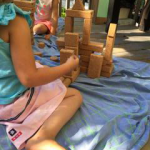
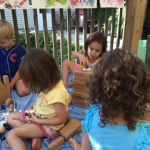
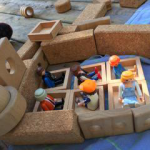

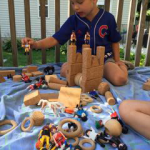
It is always developmentally appropriate because the child creates at the level they are at. It’s very personal and very perfect! It is gender neutral. I also love to watch the mentoring and scaffolding that happens when children watch what their friends are building and how it was built. Block building follows the natural flow of children’s curiosity and concentration. They can try something over and over again until they are satisfied with their creation. When opportunities for math occur in such enriched environment and children are given the time to create, and think, they will develop the skills needed to be successful in the future.Our block area is also an ideal setting for loose parts to be added in. People are often added to the block area in the form of fairies, guys or Playmobile characters to name of few. We like people that don’t have a screen character associated with them because it allows for more imagination and creativity without repeating a scene we saw on television yesterday.
Our block area is also an ideal setting for loose parts to be added in. People are often added to the block area in the form of fairies, guys or Playmobile characters to name of few. We like people that don’t have a screen character associated with them because it allows for more imagination and creativity without repeating a scene we saw on television yesterday.
Our farm and zoo animals are added, along with rocks, sticks and other natural materials.
OUTDOOR BUILDING
If you have the great fortune to own a set of hollow blocks, taking them outdoors will change the amount of time they are played with and how they are played with. Often these blocks get lost in a closet because they are big, loud and heavy. These have all the 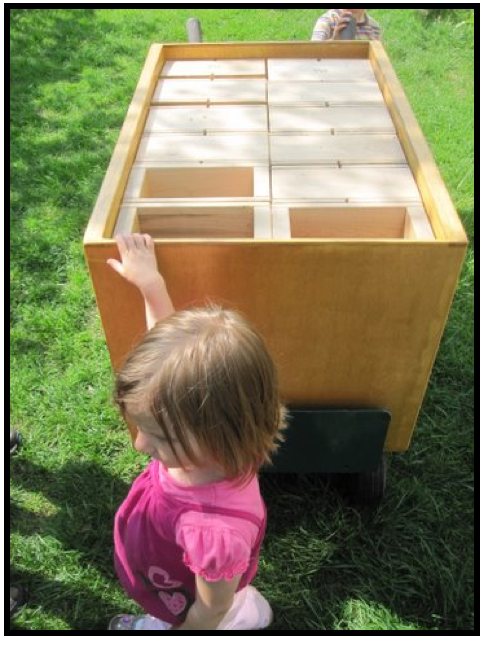 elements needed for some great outdoor building. We first built a box to store them in and added them to a pushcart. This worked well for a while, but it was still a bit difficult to get in and out of the garage to play with.
elements needed for some great outdoor building. We first built a box to store them in and added them to a pushcart. This worked well for a while, but it was still a bit difficult to get in and out of the garage to play with.
We are constantly building something. It may be in the sandbox, or in the rain garden. It may be hideout or a hut. All that building is math. It’s problem-solving and logical thinking. It’s estimating and measuring. It’s creative and risk-taking. We need to take risks to try new ideas in our math equations. It’s all so very, very good.
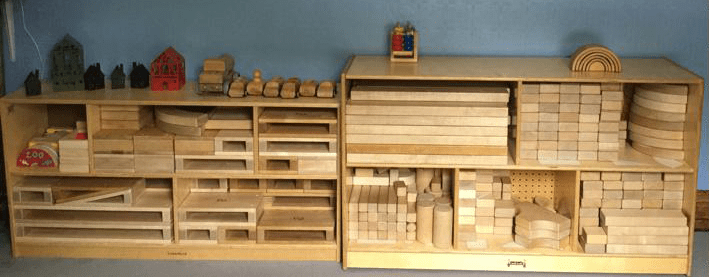
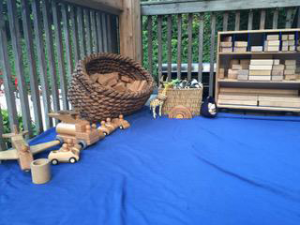
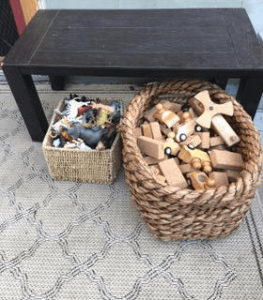

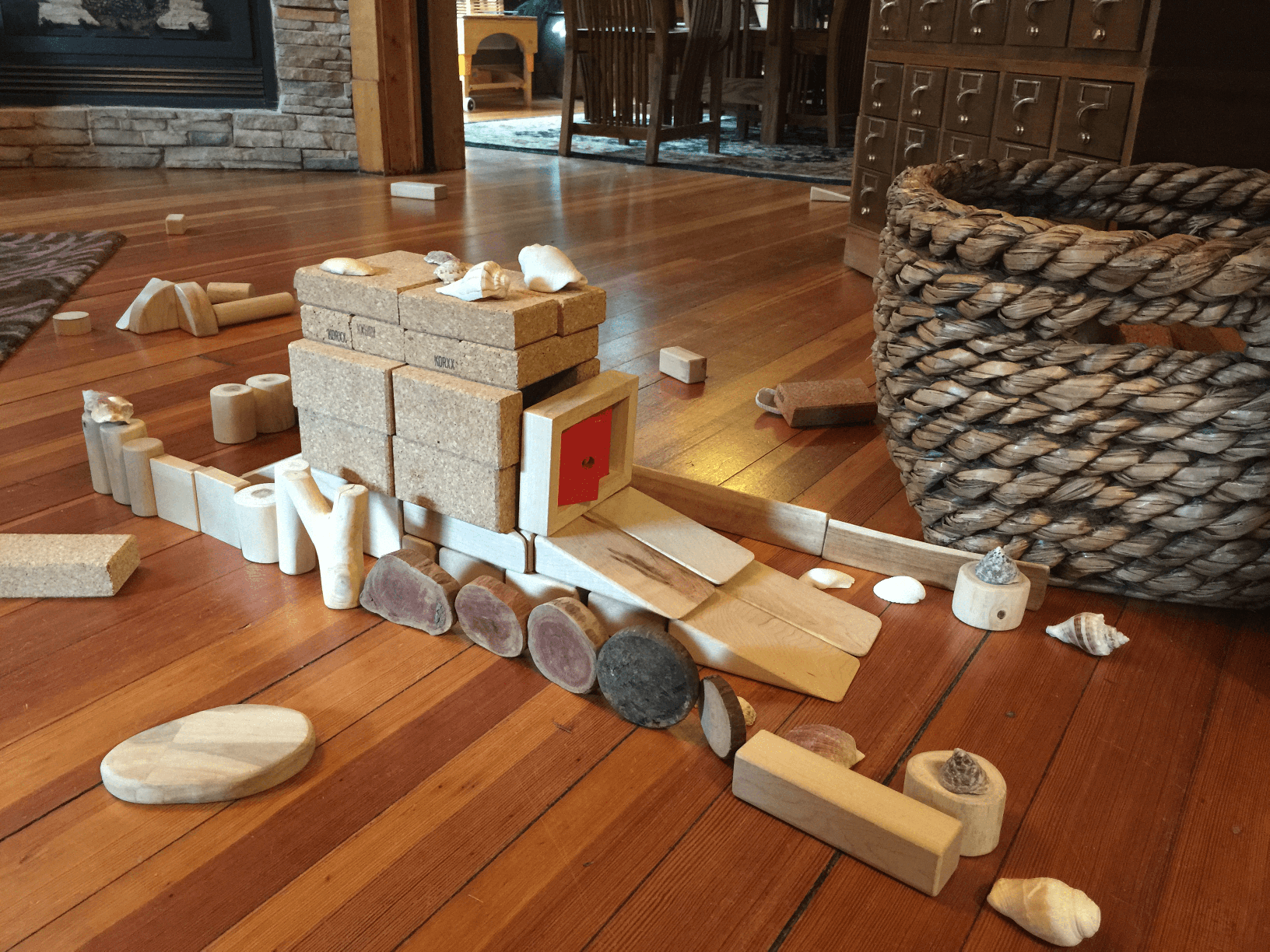
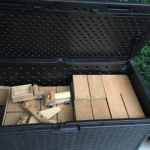
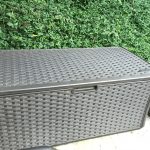


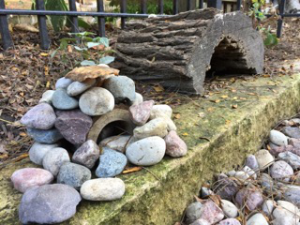
Blocks are so undervalued as a foundational math tool. They are so versatile, portable, and fun, what’s not to love?
I agree, Marilyn! If it looks like fun, it can still be learning. I could watch their play for hours! So individualized yet so open for friendship!
i think blocks is a great way for children to learn and have fun all in one.
I love having enough blocks so that several children can play in the block area together. It is a great time to watch their development – some are still doing parallel play and some are learning how to enter the play of others. Observing how others enter the play and if the ones already there will allow another to add to their block play or even change it.
Children usually enjoy a challenge such as can we make it taller?
I have also done block play using the whole group and going around the circle allowing each child to add one block of their choice. These can lead to a great discussion of how the structure changes with each added block.
I agree that it is very important to have enough blocks for several children to play and enjoy. It is amazing to hear the children discuss what they are making and how they interact. I love to see them bring in other things such as little people and build communities!!
my children love to add components to block play like building a bear house and having bears live in the house or cars to make a parking lot or roads
children like to add things to blocks like cars to make a parking garage or roadway
I love all kinds of blocks also. The animal and people collections are also added. I have not yet moved blocks outside but will be doing that next. We also have a collection of wood that I would like cut into smaller pieces for building outside.
Blocks always make children think and how to rearrange blocks so they can build different structures.
The block area is full of mathematical processes: how many children can play in the area; how many blocks can I stack before they fall; what will happen if I stack a small block in the large blocks? Even at clean up time, math comes into play. How many large blocks will fit on the shelf? It is a matter of counting, being persistent and flexible in placement of the blocks, and being a problem solver. Listen to the children while they build. They communicate with each other about the possibilities of their creations, who will be a part of the team and who will be at the top of the stack.
I agree that blocks are undervalued, it peaks children’s interest.
I love the focus on this blog post, blocks, all sorts of blocks are full of enrichment when utilized in teaching. Also, blocks are flexible in terms of math and reasoning. A teacher can create problems that are solved with reasoning or counting when using blocks. Like asking questions that focus on how many triangle or square blocks does it take to build a house or car.
Block area is a essential for children because is a good introduction in engineer area.
Blocks are great for so many ages and different activities, not just towers, but tunnels and bridges and…the imagination is the only stop.
we use soft blocks with our toddlers and its probably their favorite thing to do. we count as we stack the blocks on top of one another and they think it’s the most hilarious thing when they fall
The children in the classroom gravitate to blocks all the time. It’s enjoyable to watch each make their own creation with the same blocks.
I can not believe how many blocks of all shapes and sizes you have. Your students are so luck you have this type of learning environment. What wonderful ways you use them.
Blocks are always fun for any age level.
The block area is important to the early childcare centers. This is how you can observe that children are learning from their environment. Building buildings in their neighborhoods. Then encourages their imagination. Like build a store and imitate what happens in a store.
I too love block play! I had not heard of a couple you mentioned. Thank you for bringing them to my attention.
blocks are great measuring tools. We have measured with them in the daycare many times over many years.
Block play is great for teaching fundamentals of spatial awareness, physics, shapes, tangrams etc. Stacking the blocks allows for problem solving to see how we can manipulate the blocks to build them as high as possible.
I always love using blocks for learning. They get to play as they learn!
I love this activity. I love watching the students build and rebuild and design and imagine. They are learning as they play.
Oh, how I love this! Block play is so rich. In my kindergarten classroom, we were always moving in new materials and different photographs related to themes, homes, and buildings around the world. I had a roll of paper with writing materials available for recording and then sharing out our ideas. Free Choice Time was my favorite time of day!
I love the idea of using different building materials other than blocks.
Our classroom has blocks too, but I see many shapes that we don’t have! Will have to see if I can track them down (or make them).
Blocks are a foundational toy in my home daycare. Early math learning is just one of a myriad of educational opportunities blocks provide, and I agree with you- the more blocks, the more learning, play, and FUN!